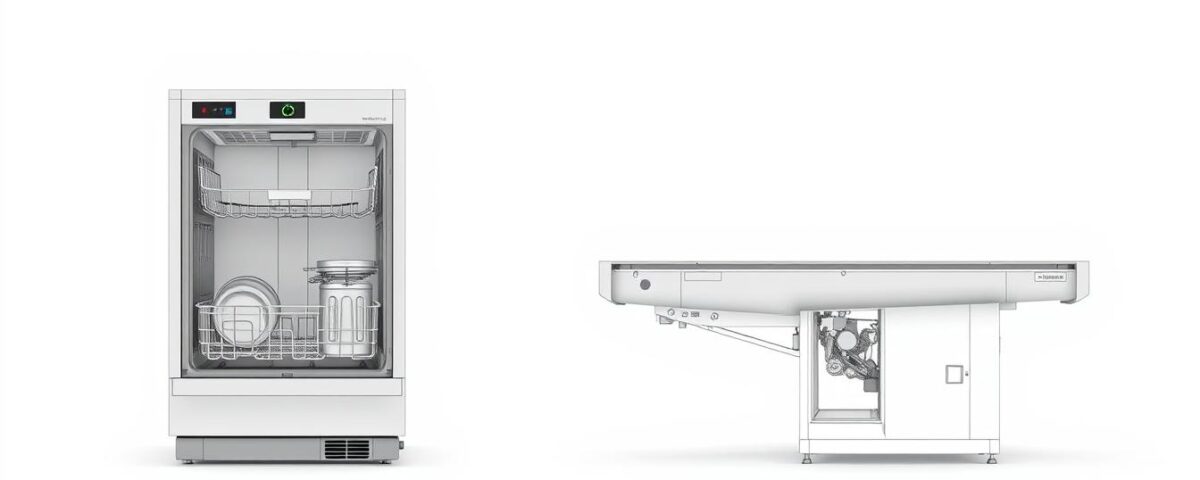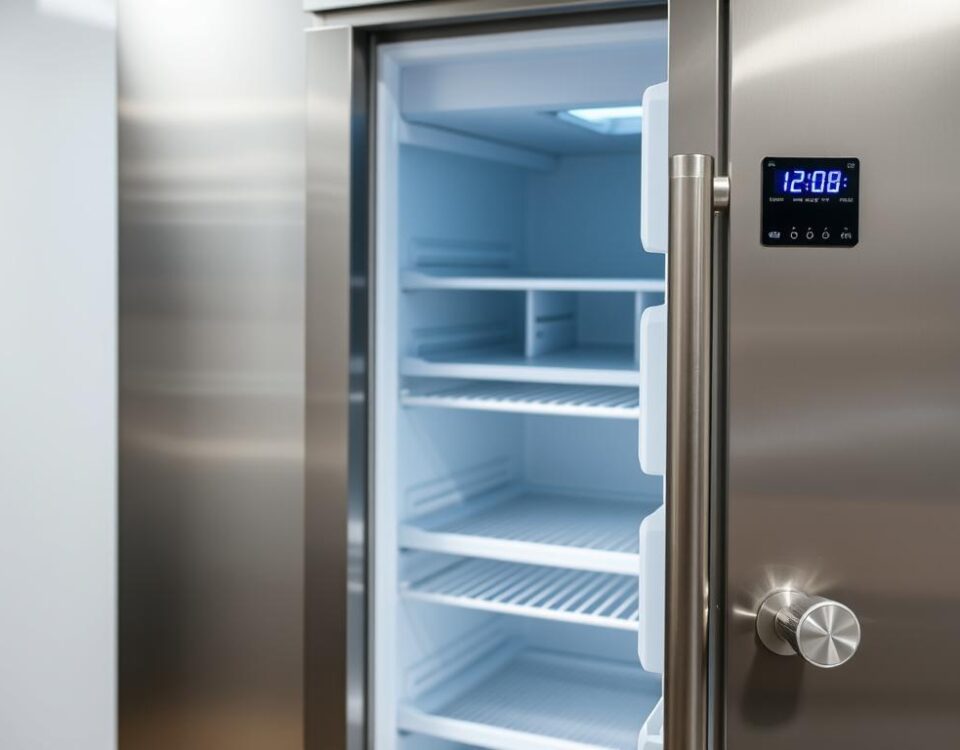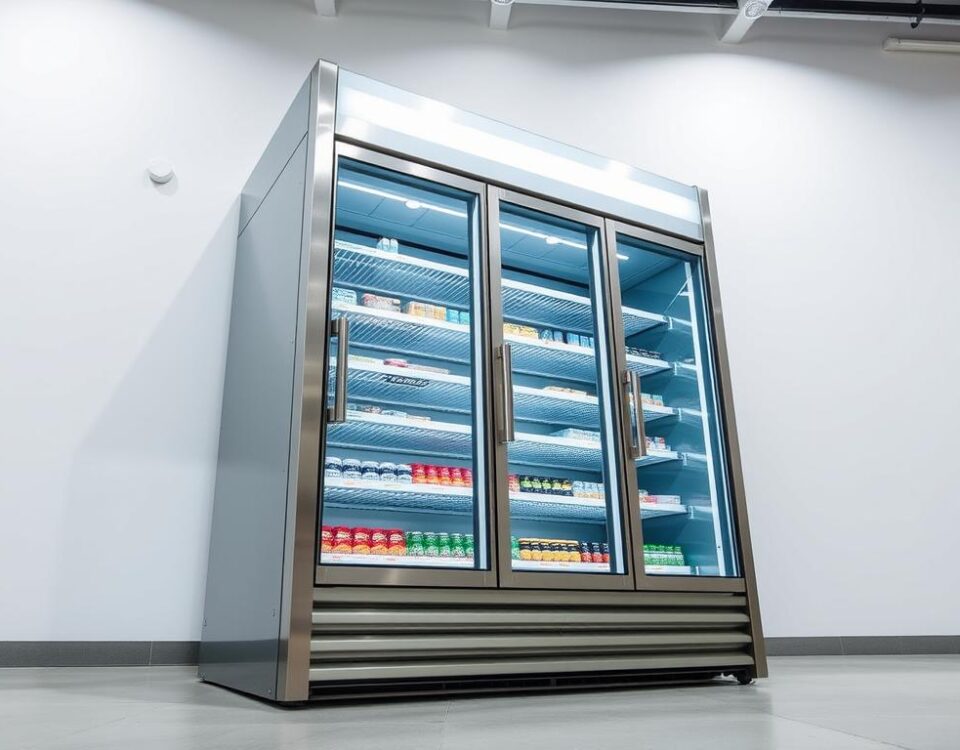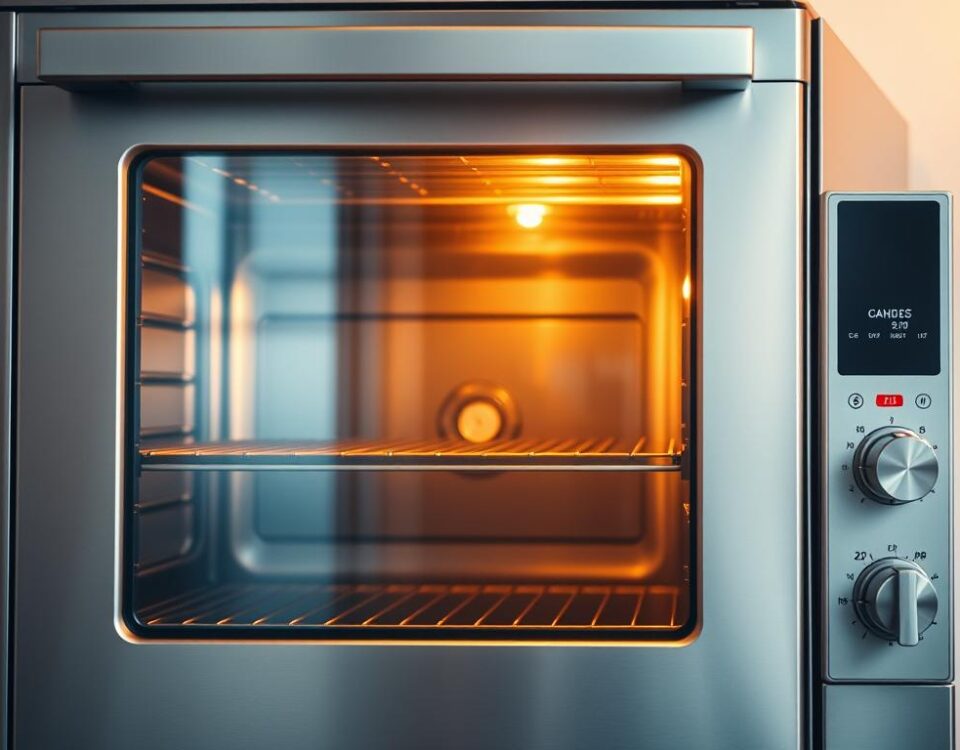
5 Commercial Fryers Entered the Kitchen—Here’s the One That Won
September 11, 2025
Why Pressure Fryers Cook the Juiciest Chicken (Backed by Data)
September 12, 2025Running a successful restaurant is a balancing act between providing excellent service and maintaining a clean, efficient kitchen. I recall a busy Friday night at a popular eatery where the staff was struggling to keep up with the demand for dishes, highlighting the critical role a reliable commercial dishwasher plays in any foodservice operation.
Did you know that a well-chosen dishwasher can significantly reduce labor costs and improve kitchen efficiency? In fact, a study found that the right dishwasher can cut down dishwashing time by up to 50%. With the variety of options available, making an informed decision is crucial.
As you navigate the decision between different types of commercial dishwashers, understanding their speed and footprint is key. Will a door-type or a conveyor dishwasher be the best fit for your restaurant? Let’s dive into the details to find out.
Key Takeaways
- Understand the key differences between door-type and conveyor dishwashers.
- Learn how the speed capabilities of each type can impact your kitchen’s efficiency.
- Discover the footprint requirements for different dishwasher types and how they fit into your kitchen layout.
- Make an informed decision based on your restaurant’s specific needs and operations.
- Explore how the right dishwasher can improve staff productivity and reduce operational costs.
Understanding Commercial Dishwasher Types
Commercial dishwashers are not one-size-fits-all solutions; they come in different types to suit various kitchen needs.
High-Temperature vs Low-Temperature Options
When it comes to commercial dishwashers, one key distinction lies in their sanitization methods. High-temperature dishwashers use water heated to at least 180°F during the final rinse cycle, effectively killing bacteria without chemicals and helping dishes dry faster. On the other hand, low-temperature dishwashers rely on chemical sanitizers like chlorine or quaternary ammonium compounds, which can be gentler on certain materials but may leave residues.
The choice between high and low-temperature options affects not only sanitation but also energy consumption, water usage, and operational costs. Understanding these differences is crucial for selecting the right dishwasher for your business.
The Main Commercial Dishwasher Categories
The main commercial dishwasher categories include undercounter, door-type, and conveyor dishwashers, each with different capacities and applications. Undercounter dishwashers are ideal for small kitchens or establishments with limited space. Door-type dishwashers offer a balance between capacity and footprint, while conveyor dishwashers are designed for high-volume operations, providing continuous washing capabilities.
Each of these categories has distinct advantages in terms of capacity, speed, space requirements, and suitability for different food service operations. Understanding these fundamental differences will provide the foundation for comparing door-type and conveyor dishwashers specifically.
Door-Type Dishwashers: Features and Capabilities
The door-type dishwasher is a versatile commercial appliance that fits into almost any warewashing setup. These dishwashers are designed to offer a balance between the compactness of undercounter models and the high capacity of conveyor systems.
How Door-Type Dishwashers Work
Door-type dishwashers feature a pull-down hood design, allowing for easy loading and unloading of dish racks. This mechanism makes them user-friendly for kitchen staff. The wash cycle typically involves a combination of hot water and detergent, ensuring thorough cleaning.
Speed and Capacity: 35-60 Racks Per Hour
These machines can process between 35-60 racks per hour, depending on the model and settings. This speed and capacity make door-type dishwashers suitable for small to medium-sized restaurants serving around 100-200 meals per service.
Footprint and Space Requirements
The footprint of door-type dishwashers is relatively compact, typically requiring about 2-3 feet of counter space. They offer more vertical space than undercounter models, accommodating larger items like pots, pans, and full-sized oven trays.
In summary, door-type dishwashers are an excellent choice for establishments needing a moderate capacity without the space requirements of conveyor systems. Their versatility, reasonable capacity, and ability to handle various dishware types make them a preferred option in many commercial kitchens.
Conveyor Dishwashers: Features and Capabilities
For large foodservice venues, conveyor dishwashers offer unparalleled efficiency. These machines are designed to handle high-volume dishwashing needs, making them ideal for banquet halls, hospitals, cafeterias, and other large-scale foodservice operations.
How Conveyor Dishwashers Work
Conveyor dishwashers utilize an automated belt system to move racks through various washing zones, ensuring a continuous and efficient cleaning process. This mechanism allows for a steady workflow in busy kitchens, reducing bottlenecks during peak service times.
Speed and Capacity: 150-200+ Racks Per Hour
Conveyor dishwashers represent the highest capacity option for commercial kitchens, capable of processing between 150-200+ racks per hour. This impressive throughput makes them ideal for high-volume operations like hotels, hospitals, and large restaurants serving 400+ meals per service.
Footprint and Space Requirements
While conveyor dishwashers require significantly more space than door-type models, typically needing at least 5-8 feet of linear space plus additional room for loading and unloading stations, they offer unmatched efficiency for high-volume operations. Their larger footprint is a trade-off for the advanced features and capabilities they provide.
Conveyor dishwashers can be customized with various configurations and add-ons to meet specific operational needs, including multiple wash and rinse zones for optimal cleaning, heat recovery systems, and powerful pumps to handle heavily soiled items.
Door-Type vs Conveyor Dishwasher: Speed Comparison
For restaurants and foodservice providers, understanding the speed differences between door-type and conveyor dishwashers is essential for optimizing kitchen operations. The disparity in their throughput capacities is significant, with door-type dishwashers processing 35-60 racks per hour and conveyor dishwashers handling 150-200+ racks per hour.
Throughput and Efficiency Differences
The substantial difference in throughput capacity between door-type and conveyor dishwashers translates to a considerable disparity in their efficiency. Door-type dishwashers can clean approximately 875-1,500 dishes per hour, assuming 25 dishes per rack. In contrast, conveyor dishwashers can process 3,750-5,000+ dishes per hour, representing a 3-4 times increase in capacity. This difference significantly impacts workflow, particularly during peak service hours when the demand for clean dishes is high.
Peak Hour Performance
During peak hours, the continuous operation of conveyor dishwashers can prevent dish shortages, unlike the batch processing of door-type machines. This continuous operation not only affects the availability of clean dishes but also influences staffing needs and kitchen organization. By understanding these differences, restaurants can make informed decisions about which type of dishwasher best suits their operational demands.
Door-Type vs Conveyor Dishwasher: Footprint Comparison
When deciding between a door-type and conveyor dishwasher, understanding their footprint is crucial for optimizing kitchen layout. The spatial requirements of these dishwashers can significantly impact the overall design and efficiency of a commercial kitchen.
Installation Space Requirements
Door-type dishwashers have a minimal footprint, typically requiring about 2-3 feet of counter space with a depth of approximately 30 inches. This makes them suitable for kitchens with limited space. In contrast, conveyor dishwashers need at least 5-8 feet of linear space, plus additional room for loading and unloading stations. The height requirements also differ, with door-type models needing clearance for the hood to open fully, while conveyor models require consistent height throughout their length.
Kitchen Layout Considerations
Evaluating your kitchen layout is essential to determine which dishwasher type integrates most effectively with your existing workflow. For kitchens with unusual shapes or space constraints, creative solutions and arrangement ideas can be applied for both dishwasher types. The choice of dishwasher affects the overall kitchen design, including considerations for water lines, drainage, ventilation, and electrical requirements. By understanding these factors, you can make an informed decision that optimizes your kitchen’s efficiency and layout.
Cost Considerations: Purchase and Operation
When considering a commercial dishwasher, understanding the total cost of ownership is crucial. This includes both the initial purchase price and ongoing operational costs.
Initial Investment Comparison
The initial cost of commercial dishwashers varies widely. Door-type dishwashers generally cost between $4,000-$8,000, while conveyor dishwashers typically start at $10,000 and can exceed $15,000 depending on features and capacity. This significant difference in initial investment is a critical factor for businesses to consider.
Water and Energy Consumption
Operational costs include water and energy consumption. Door-type models typically use 1-1.5 gallons per rack, whereas conveyor systems might use 0.5-1 gallon per rack but process many more racks. Despite conveyor models having higher hourly energy usage, their total energy consumption can be comparable to door-type dishwashers when considering their higher throughput.
Long-Term Operational Costs
Long-term operational costs encompass maintenance, detergent, rinse aid, and potential water softening requirements. Conveyor dishwashers, due to their complexity, may require more frequent maintenance. A comprehensive cost-per-rack calculation considering all operational expenses helps businesses understand the true cost difference beyond the initial purchase price.
For businesses concerned about sustainability, there are energy and water-efficient models in both categories that can help reduce environmental impact and utility costs.
Which Dishwasher Type Is Right for Your Business?
When it comes to selecting a commercial dishwasher, understanding your business needs is key. The right dishwasher can significantly impact your kitchen’s efficiency and productivity.
Small to Medium Restaurants
For restaurants serving up to 150-200 meals per service, door-type dishwashers often provide the best balance of capacity, space efficiency, and cost. These establishments typically have limited space and moderate dish volumes, making door-type dishwashers an ideal choice.
Large-Volume Operations
Large-volume operations, such as cafeterias, hospitals, and hotels, require conveyor dishwashers to handle high volumes efficiently. Despite their higher cost and space requirements, conveyor dishwashers are necessary for these businesses to manage their dishwashing needs during peak periods.
Specialized Foodservice Establishments
Specialized establishments like bars, cafes, and catering operations have unique dishwashing needs. The type of food they serve and the volume of dishes can dictate whether a door-type or conveyor dishwasher is more suitable. For example, establishments serving greasy or sticky food may require more powerful washing capabilities.
Ultimately, choosing the right commercial dishwasher involves considering your business’s specific needs, including meal volume, dish types, peak service intensity, and kitchen staffing levels. By understanding these factors, you can make an informed decision that supports your business’s efficiency and growth.
Conclusion
Choosing the right commercial dishwasher is crucial for your restaurant’s efficiency. The decision between door-type and conveyor dishwashers depends on your specific needs, including operation size, dish volume, available space, and budget. For small to medium operations, door-type dishwashers offer a balance of capacity and space efficiency. In contrast, conveyor systems are ideal for high-volume establishments. Consider your current needs and future growth projections when making this important equipment decision. Proper maintenance will extend the life of your dishwasher and ensure optimal performance. Consulting a commercial kitchen equipment specialist can provide personalized recommendations for your kitchen.
FAQ
What are the main differences between door-type and conveyor commercial dishwashers?
The primary differences lie in their design, functionality, and capacity. Door-type dishwashers are ideal for smaller to medium-sized establishments, offering a compact footprint and flexibility, while conveyor dishwashers are suited for high-volume operations, providing rapid throughput and efficiency.
How do I choose the right commercial dishwasher for my restaurant?
To make an informed decision, consider factors such as your establishment’s size, the volume of dishes you need to clean, available kitchen space, and your budget. It’s also crucial to think about the type of foodservice you operate and your specific sanitation needs.
What are the benefits of using a high-temperature commercial dishwasher?
High-temperature dishwashers offer superior sanitizing capabilities, effectively eliminating bacteria and other pathogens. They are particularly beneficial for establishments that require stringent sanitation standards.
How much water and energy do commercial dishwashers consume?
Water and energy consumption vary significantly between different models and types of dishwashers. Generally, modern commercial dishwashers are designed to be efficient, but it’s essential to check the specifications of a particular model to understand its consumption patterns.
Can I install a conveyor dishwasher in a small kitchen?
While conveyor dishwashers are typically larger and require more space than door-type models, some compact conveyor systems are designed for smaller kitchens. It’s crucial to assess your kitchen’s layout and available space before making a decision.
What are the long-term operational costs associated with commercial dishwashers?
Long-term costs include energy and water consumption, maintenance, and potential repairs. Choosing an efficient model and implementing regular maintenance can help minimize these costs over time.
Are undercounter dishwashers a viable option for my business?
Undercounter dishwashers are an excellent choice for establishments with limited space. They offer the benefits of a full-size dishwasher in a compact footprint, making them ideal for smaller kitchens or those with specific layout constraints.



